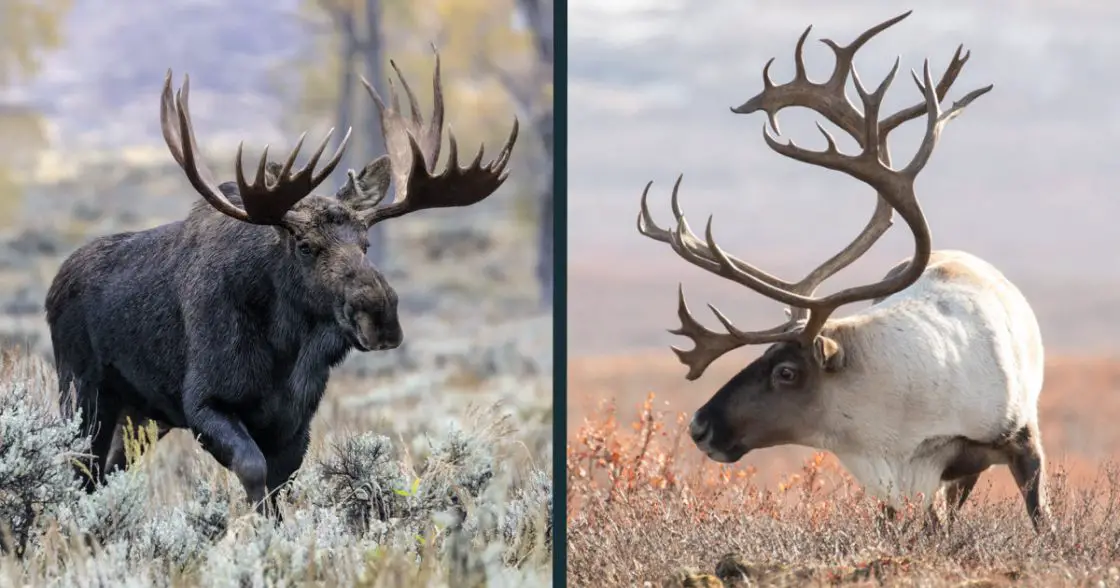At first glance, there are some similarities between the moose and the caribou. They’re both large species of deer. They also have some similar features including hooves, brown fur, and antlers. Keep reading to find our comprehensive moose vs caribou comparison and learn the differences between these two species.
For all their similarities, moose and caribou differ greatly when it comes to size, migration patterns, and diet.
Moose vs Caribou – Key Differences
Below is a chart comparing the primary features of caribou and moose. You’ll see these features discussed in greater detail later on.
| Caribou | Moose |
|---|---|
| 2.75 to 5 feet tall | 4.5 to 6.8 feet tall |
| Weigh 176 to 396 pounds | Weigh 440 to 1543 pounds |
| Brown, white coats | Brown, black coats |
| Live in tundra, mountainous areas, northern forest | Live in northern forests with bodies of water |
| Omnivore | Herbivore |
| Migratory | Non-Migratory |
| Polygamous | Polygamous |
Species Comparison
While we once believed that there were only two subspecies of North American moose, scientists now know that there are four. These include:
- Eastern Moose – Eastern Canada, Northeastern U.S.
- Western Moose – British Columbia to western Ontario, Michigan’s Upper Peninsula, northern Wisconsin, Minnesota, and North Dakota.
- Alaska Moose – Alaska and Western Yukon.
- Shiras Moose – Wyoming, Idaho, Utah, Colorado, Washington, Oregon, and Montana.
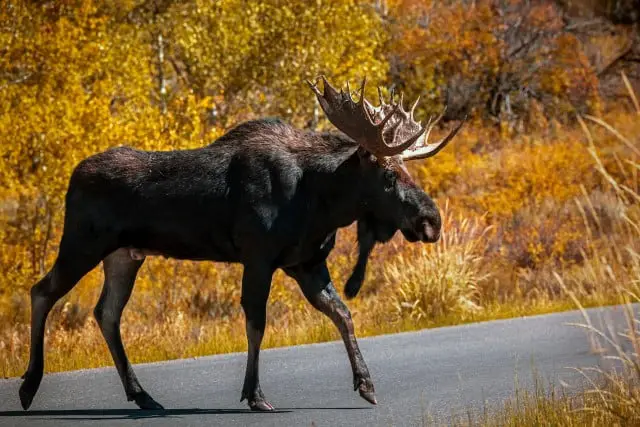
The Alaska moose is the largest subspecies and the Shiras is the smallest subspecies.
Caribou (also referred to as reindeer) have far more subspecies types. There are nine caribou subspecies, and we group these into two major types: Tundra reindeer and Woodland reindeer.
The Tundra type has six subspecies while the Woodland has three subspecies.
Physical Appearance
Both moose and caribou most often have brown fur which allows them to blend in to their natural habitat. However, caribou differ in that they can be almost entirely white in some areas.
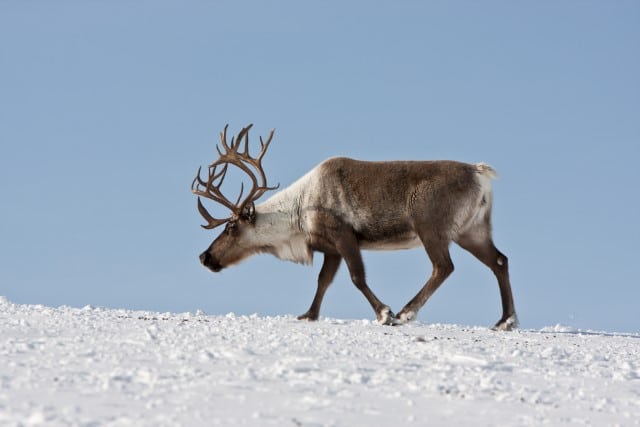
Caribou have a fold of loose skin on their neck and long white hair on their throat.
Both male and female caribou have antlers, but the female’s antlers are smaller and straighter. They are the only species of deer where females grow antlers, and do so because they use their antlers to dig for food under the snow.
Caribou have long legs and wide, flat, hollow hooves which help them dig and walk on snow.
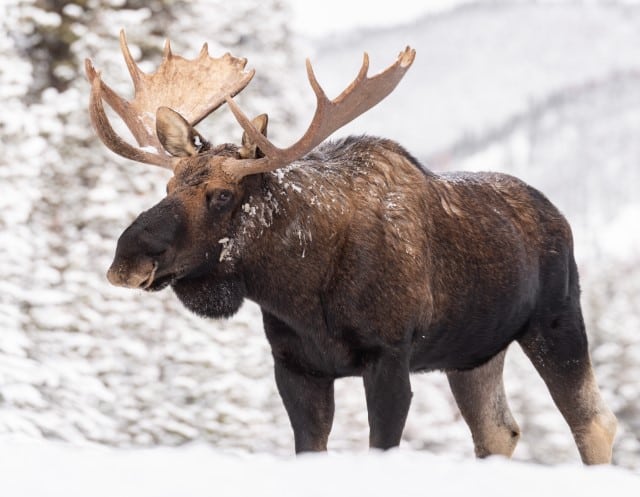
We can distinguish moose by the large hump over the shoulders, as well as their large rotating ears. While most moose have brown hair, a few have black hair.
The shape of their nose, and their large palmate antlers are also distinguishing characteristics.
Size
Adult caribou generally weigh between 176 to almost 400 pounds. Like moose, males are significantly larger than females. Some male caribou can be much larger than this, with some even tipping the scales at 700 pounds.

Caribou heights vary significantly, ranging between 2.75 and 5 feet.
Moose are the largest and heaviest deer species, and will often be immediately distinguished by their height. The male moose (otherwise known as bull moose) shoulder height is usually around 6 feet, and females tend to be slightly shorter.
The moose is considered the tallest mammal in North America.
Male moose weigh anywhere between 800-1500 pounds. The females weigh significantly less, usually between 500-700lbs.
However, the female’s weight increases significantly after mating season (when she is pregnant).
Antlers
Caribou are the only deer species where both females and males grow antlers. Caribou shed their antlers each year and grow new ones.
The time of year they shed their antlers is different for males and females. Male caribou drop theirs in November and regrow them in the spring.
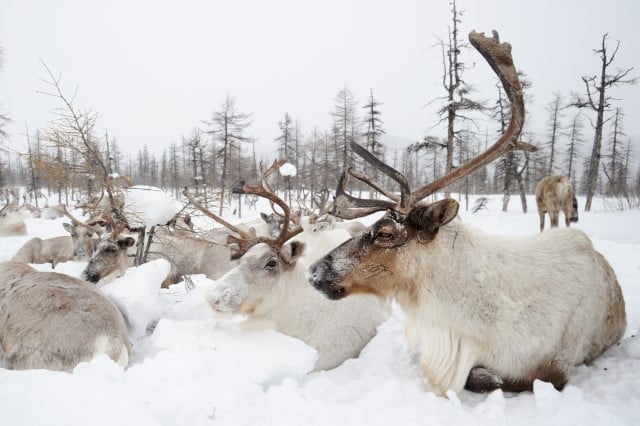
Females keep their antlers through the winter, then shed them in May after their calves are born.
It only takes a few weeks for caribou to regrow their antlers, which can weigh over 20 pounds and measure over 3 feet in length.
Unlike caribou, female moose do not have antlers. Male moose antlers can be as wide as 6 feet from end to end. Velvet covers them and is shed late in the season (as it is with most deer species).
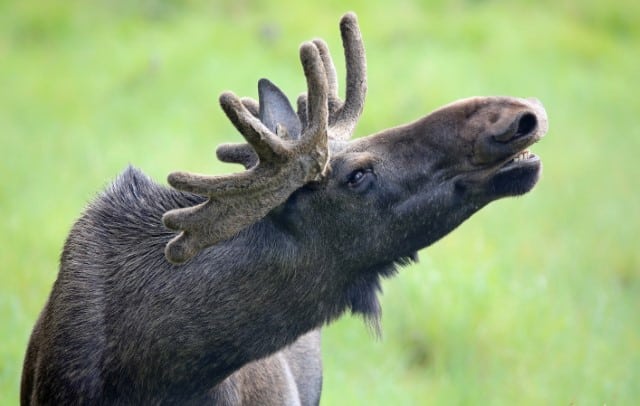
Moose antlers are usually paired and resemble the palm of a hand with outstretched fingers.
Moose shed their antlers every winter. After the male moose reaches his prime, antler size starts to decrease each year.
While the age of the animal can be a factor in antler size, it’s no the only determinant.
Habitat Preferences
Moose and caribou actually live in pretty similar habitats, with a few exceptions.
Both like to live in forests with abundant food sources and plenty of places to hide from predators.
Caribou live in North America, Norway, Greenland, Siberia, and Finland. Their habitats include tundra regions, subarctic forests, and mountainous habitats.
Moose live in northern North America and northern Eurasia. There is a large moose population in Canada and Alaska.
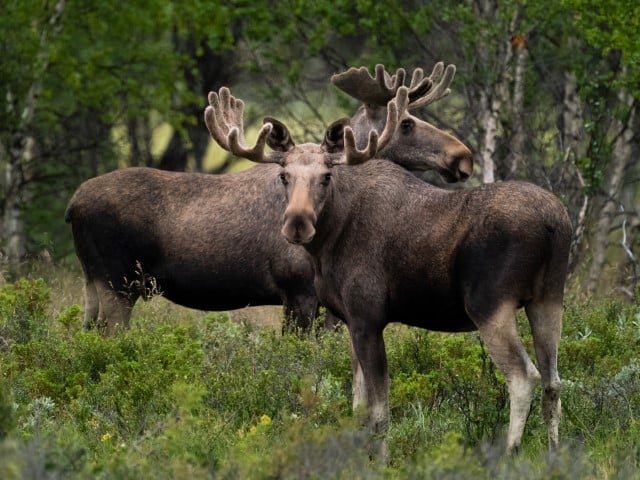
Moose live in areas that have seasonal snow cover and prefer colder climates. They cannot generally tolerate warmer climates because they cannot sweat to cool themselves down.
Additionally, moose fur is very insulated and is designed to keep the animal warm. Their digestive system produces natural heat as it processes food, too.
One difference between Moose and Caribou is that Moose typically prefer to live near water. They enjoy the soft, nutrient rich water plants that grow around the edge of these water bodies, and will also wade into the water and dip their heads below the surface to eat weeds and vegetation growing below the water’s surface.
Diet
The diet of caribou and moose depends on the season. Foods common in the caribou diet are:
- Grass
- Mushrooms
- Twigs
- Lichens
- Fruits
While the vast majority of the caribou’s diet is vegetation, they are considered omnivores and can also tolerate animal protein. They will occasionally eat small animals or fish.
In the winter, the caribou’s environment is normally covered in snow, so they feed mainly on lichen. Moose are herbivores, so they exclusively eat greens and vegetation.
In the warm months, moose feed on:
- Leaves
- Twigs
- Trees
- Shrubs
They’ve also been known to consume aquatic plants. In the winter months, moose feed on woody plants.
Migration Patterns
Caribou are migratory animals that travel hundreds or thousands of miles over the course of a year. The migration distance tends to depend on the size of the herd.
Large herds tend to migrate longer distances, while smaller herds tend to migrate shorter distances.
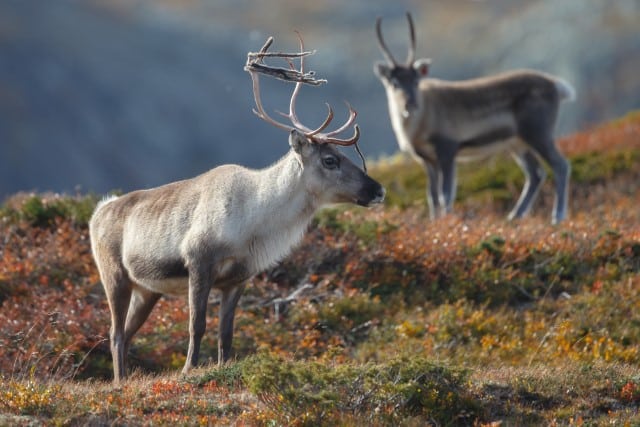
Some of the larger herds migrate as far as 400 miles between their summer and winter locations. In addition, caribou do not migrate in a straight line.
Satellites have tracked caribou moving to and fro across a wide land area, traveling up to 3,000 miles in a single year.
Moose are not naturally migratory animals. They do travel up to 18 miles within the radius of their habitat, but only seasonally to find alternate sources of food.
It is also believed that moose will not make an effort to go back to their original home location if they somehow end up far away.
This has been tested by scientists who moved a number of moose to a new habitat for environmental reasons. Almost no moose made an effort to migrate back to their original location.
Behavior
The behavior differences between moose and caribou are one of the most significant in our moose vs caribou comparison.
Caribou are social animals and they travel in groups called herds. The size of caribou herds vary greatly: some have a few hundred, while the Porcupine Caribou herd has over 200,000 animals.
Caribou are known for their excellent swimming skills. They can swim as fast as 6.2 miles per hour.
Their hooves act as paddles in the water and their coats help them stay afloat and warm. They can swim through icy waters at all times of the year.
On land, the Caribou is the fastest species of deer, and can run as fast as 49-50 miles per hour, although they rarely run at full speed.
Male caribou are also known to fight each other, especially during mating season. With their sharp antlers, sometimes they end up with serious injuries.
In general, caribou are quiet animals aside from the occasional snorting sound.
Moose are very active during the day. Like the caribou, they are excellent swimmers and often cross bodies of water to get to another food source. On land, they can run as fast as 35 miles per hour.
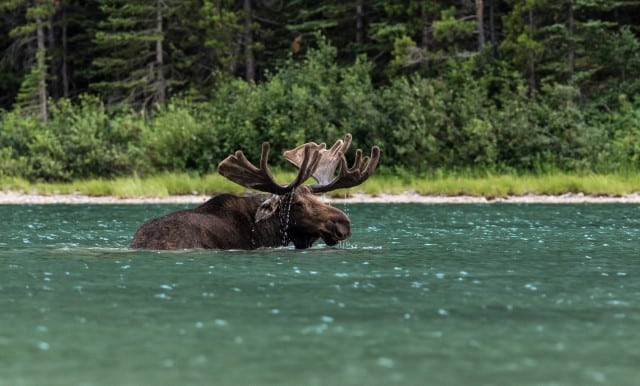
Because of their height, they can trot at 20 miles per hour.
When comparing Caribou vs Moose you should note that unlike the Caribou, moose are solitary animals and do not travel in herds.
Reproduction
The caribou’s breeding season starts in October. They are polygamous breeders and fight each other to mate with females.
Females generally start breeding when they are 2.5-3 years old.
Their gestation period is between 225 to 235 days. Caribou are born in May or June when there is an abundant supply of food.
While moose are otherwise solitary animals, they become very social during the mating season. The male moose makes loud noises to attract females in late fall.
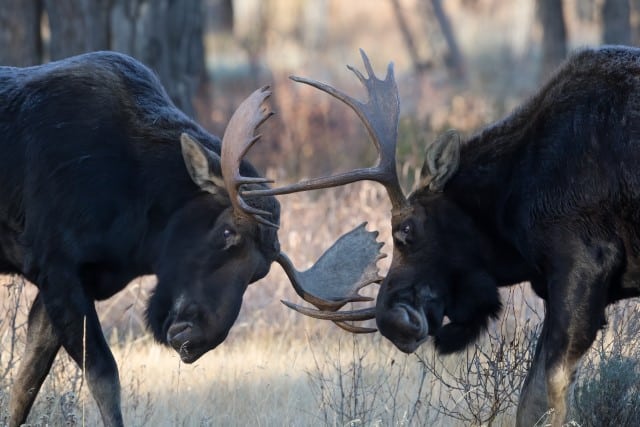
Female moose are often led to a single location together called a “Harem herd.” Here, male Moose fight with each other to mate with the females.
The gestation period is 231 days. A baby moose (called a calf) weighs about 35 pounds when it is born. It can immediately stand up on its legs.
They gain about 2 pounds a day feeding exclusively on their mother’s milk.
Early Origins
The word caribou is derived from the Native American word qalipu, which means “snow-shoveler.” They got this name because indigenous people saw caribou pushing snow around with their hooves and antlers to get to food sources underneath.
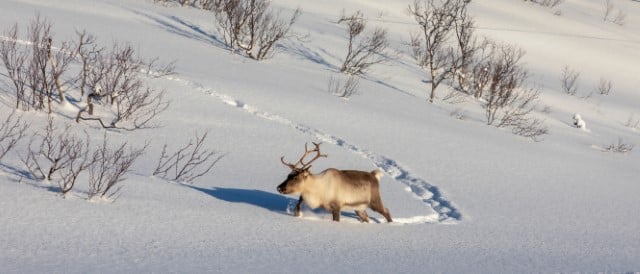
It is believed that the word transitioned from qalipu to Caribou when French explorers discovered the animal in the 17th century.
In ancient cultures, Caribou represented endurance and regeneration.
Moose were of great importance to Native populations in Canada and the northern United States, mostly as a food source.
Moose did not play a significant role in Native American folklore or symbolism, with the exception of the Wabanaki tribe who believed that the moose was once a monster who was defeated by God Glooskap.
Hunting
Caribou are commonly hunted for sport in North America. However, there are restrictions when it comes to the time of year when hunting is permitted. Also, you’re limited in the number of caribou you can kill.
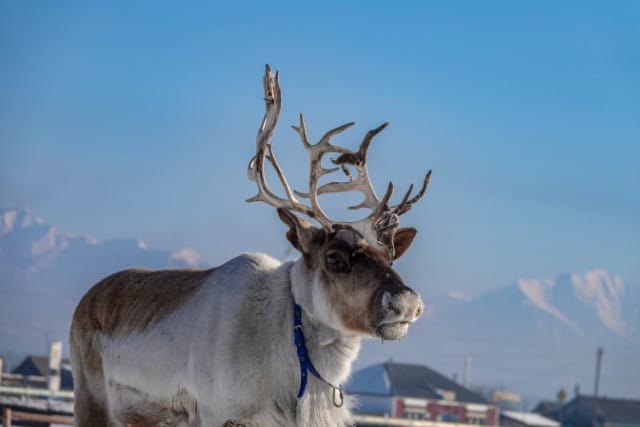
Moose hunting is permitted in North America but permits and restrictions vary greatly by state. Many states give out a limited number of hunting permits per year and hold an annual lottery to determine which hunter will have the chance to hunt for moose.
As you can see, although caribou and moose are members of the deer species, they are both very unique animals. Each has its own distinctive look, behaviors, native range, and way of life.
Final Thoughts: Moose vs Caribou
Now that you’ve read this comprehensive moose vs caribou comparison, you know how to differentiate these animals. While some people find them quite similar, seasoned hunters and wildlife enthusiasts know how to tell the difference.
We’ve learned how moose and caribou differ in these areas:
- Physical appearance
- Size
- Antlers
- Habitat preferences
- Diet
- Migration patterns
- Behavior
- Reproduction
- Early origins
- Hunting

